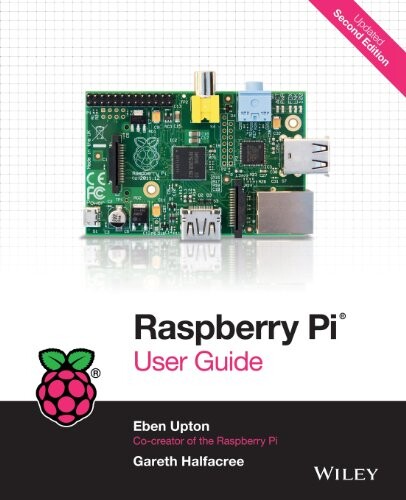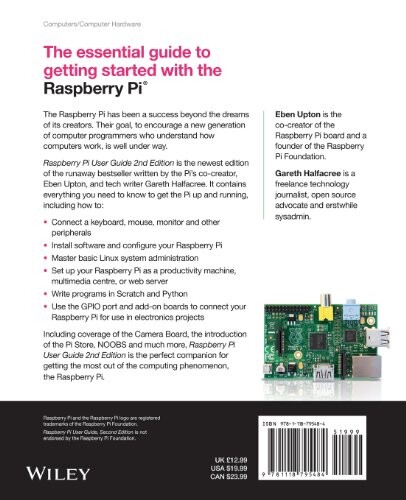User Guide
Description
The essential guide to getting started with Raspberry Pi computing and programming. This is your complete guide to using and getting the most out of the world’s first, true compact computer. It is suitable for complete beginners, and it covers similar ground:
- Connect a keyboard, mouse, monitor and other peripherals
- Install software and configure your Raspberry Pi
- Master basic Linux system administration
- Set up your Raspberry Pi as a productivity machine, multimedia centre, or web server
- Write programmes in Scratch and Python
- Use the GPIO port and add-on boards to connect your Raspberry Pi for use in electronics projects
This book has more about how to use and configure the Pi through its terminal window, and as such is a better grounding for those who want to get at the nuts and bolts of the machine. For example: it tells you how to make the Pi adopt a certain screen resolution if your screen is not auto-recognised, how to re-partition the ram, and it has more about the signals and interfaces available to external hardware. The Dummies book has more on writing games, and a step-by-step example of hand making gamer-friendly external interface hardware for another game. Adults, kids, and devoted hardware hackers, now that you've got a Raspberry Pi, get the very most out of it with Raspberry Pi User Guide. Raspberry Pi User Guide is the perfect companion for getting the most out of the computing phenomenon, the Raspberry Pi.
Product Details
Author(s) Eben Upton, Gareth Halfacree Publisher John Wiley & Sons Inc Language: English ISBN-10: 1118795482 ISBN-13: 978-1118795484 Subject Computing: Professional & Programming Paperback: 312 pages Weight 574 g Width 185 mm Height 234 mm Spine 17 mm
Chapter Outline
- Part 1
- Meet the Raspberry Pi - An introduction to the Raspberry Pi and an overview of connecting various low level peripherals.
- Linux System Administration - A basic guide to Linux as an Operating System, and it's integration with the Raspberry Pi.
- Troubleshooting - Learn how to diagnose and overcome the majority of Raspberry Pi mishaps!
- Network Configuration - Learn how to connect your Raspberry Pi to the internet via both wired and wireless connections.
- Partition Management - Learn how to partition and configure your SD card from the Raspberry Pi.
- Configuring the Raspberry Pi - Learn how to configure your Raspberry Pi's hardware using the various config. option text files.
- Part 2
- The Pi as a Home Theatre PC - A guide to setting your Raspberry Pi up to play music and movies!
- The Pi as a Productivity Machine - How to use cloud apps, open office and image editing software with the Raspberry Pi
- The Pi as a Web Server - How to set up your Raspberry Pi as a webserver using LAMP and WordPress as examples.
- Part 3
- An Introduction to Scratch - A basic guide to programming using Scratch. User friendly and with a colourful interface, Scratch is the perfect starting place for those looking to start programming.
- An Introduction to Python - A basic guide to programming using Python. A more 'hands-on' programming software, the next step from Scratch.
- Hardware Hacking - How to get your Raspberry Pi interacting with outside elements such as LED's and sensors using the GPIO ports.
- Add-On Boards - A look at a few simple, medium level and advanced prototyping boards

